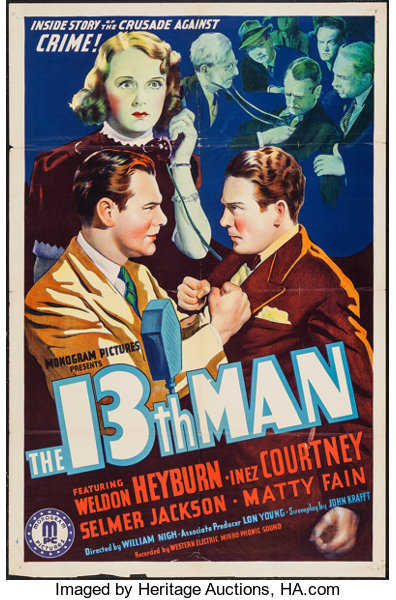
District Attorney Sutherland (William Gould) is up for re-election. He appears on Swifty Taylor’s radio broadcast as part of his bid for office. In his speech he talks about the last twelve criminals that he put behind bars. He says that he will be issuing an indictment on the thirteenth criminal tomorrow. He has a list of people and one of them is the chosen bad guy. He mentions several people that he has been investigating. He says one of these people will be the thirteenth man.
Among the chosen few are: Henry L. Martin (John Dilson), the man running against the DA for the office, Louis Cristy (Matty Fain), the nightclub owner, George Crandall (Warner Richmond), who runs crooked gambling machines, and Dr. Randolph Gorman (Sidney D’Albrook)who he suspects of graft at his hospital.
That night the DA is at the fights. Also there are the chosen few. When the fight ends and the final count is said the DA slumps over dead. The preliminary cause of death appears to be a heart attack but the final word is murder. The DA was killed by a poisoned dart dipped in curare.
When another radio investigator, Jimmy Moran (Milburn Stone), is murdered Swifty vows to find the murderer and bring him to justice.
“The Thirteenth Man” was released in 1937 and was directed by William Nigh. The movie is your average 1930’s pot boiler. The method of murder is obscure, a poison dart from a blow gun in a busy area. The cast of suspects are the usual hoods and low lives. The reveal of the murderer is the typical get everyone in a room situation. All the usual who-done-it tropes are represented.
The plot is decent and the acting OK for mostly B actors. Milburn Stone was the only one I recognized and that was from “Gunsmoke” and a few other B pictures. There is a fair amount of action and lots of quick patter between the characters. The film is not bad at all. There is a certain amount of news reporter as detective charm that is emblematic of the 30’s mystery genre.
It is considered the first film Monogram did after it reformed. At one point Monogram joined Liberty and Mascot Pictures to form Republic but that didn’t last long. Supposedly this film had been started in 1935 and was shelved until 1937 when Monogram went out on its own again. I’m not sure how important that little tidbit is since Monogram was still a low budget independent film company before and after the merger.

